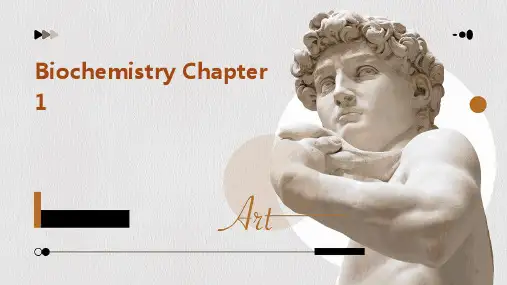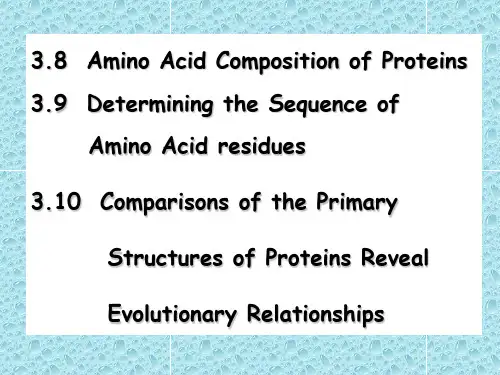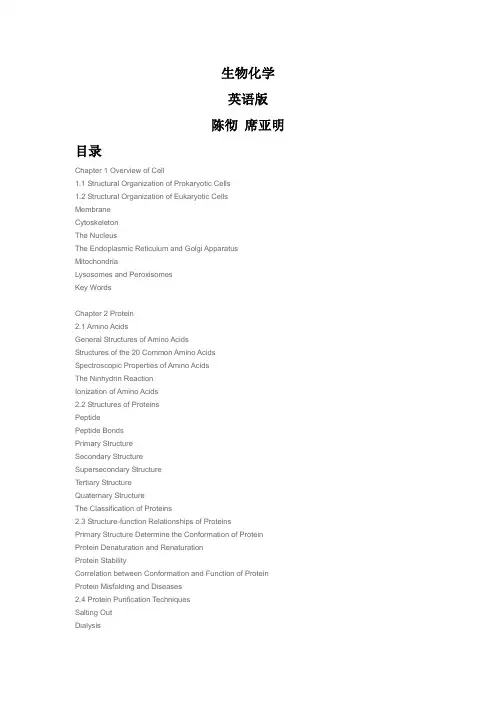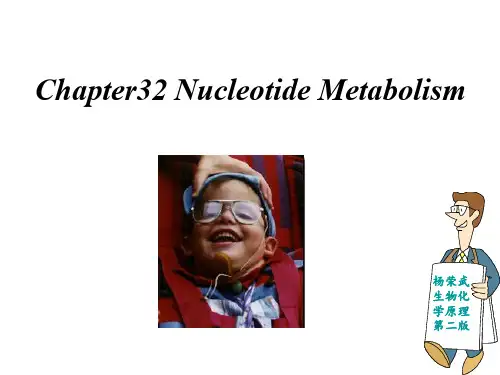生物化学英文课件Biochemistry-chapter 3
- 格式:ppt
- 大小:3.14 MB
- 文档页数:89





生物化学英语版陈彻席亚明目录Chapter 1 Overview of Cell1.1 Structural Organization of Prokaryotic Cells1.2 Structural Organization of Eukaryotic CellsMembraneCytoskeletonThe NucleusThe Endoplasmic Reticulum and Golgi Apparatus MitochondriaLysosomes and PeroxisomesKey WordsChapter 2 Protein2.1 Amino AcidsGeneral Structures of Amino AcidsStructures of the 20 Common Amino AcidsSpectroscopic Properties of Amino AcidsThe Ninhydrin ReactionIonization of Amino Acids2.2 Structures of ProteinsPeptidePeptide BondsPrimary StructureSecondary StructureSupersecondary StructureTertiary StructureQuaternary StructureThe Classification of Proteins2.3 Structure-function Relationships of ProteinsPrimary Structure Determine the Conformation of Protein Protein Denaturation and RenaturationProtein StabilityCorrelation between Conformation and Function of Protein Protein Misfolding and Diseases2.4 Protein Purification TechniquesSalting OutDialysisGel Filtration ChromatographyIon Exchange ChromatographyAffinity ChromatographyElectrophoresisSDS Polyacrylamide Gel Electrophoresis (SDS-PAGE)Isoelectric FocusingTwo Dimensional ElectrophoresisUltracentrifugationKey WordsChapter 3 Enzymes3.1 The History of Enzymes3.2 Naming and Classification of EnzymesEC 1 OxidoreductasesEC 2 TransferasesEC 3 HydrolasesEC 4 LyasesEC 5 IsomerasesEC 6 Ligases3.3 Structural Components of EnzymesApoenzymes,Cofactors and HoloenzymesActive Center of EnzymesIsozymes3.4 The Properties of Enzymatic CatalysisEnzymes Greatly Accelerate the Rates of Chemical Reactions Specificity of EnzymesControllability of Enzyme Activity3.5 Mechanism of Enzymatic CatalysisTransition State and Activation EnergyLock and Key HypothesisInduced Fit HypothesisEnzyme-Substrate Interactions3.6 Enzyme KineticsSubstrate Concentration Affects the Rate of Reactions Michaelis-Menton KineticsThe Significance of KmMeasurement of Km and VmaxEnzyme Concentration Affects the Rate of Reactions Temperature Affects the Rate of ReactionspH Value Affects the Rate of ReactionsInhibition of Enzyme Catalyzed Reactions……Chapter 4 Coenzymes and VitaminsChapter 5 Nucleic AcidsChapter 6 DNA ReplicationChapter 7 RNA Synthesis-TranscriptionChapter 8 Protein Synthesis-TranslationChapter 9 Regulation of Gene ExpressionChapter 10 Carbohydrate MetabolismChapter 11 Electron Transport and Oxidative Phosphorylation Chapter 12 Lipid MetabolismChapter 13 Amino Acid MetabolismChapter 14 Nucleotides MetabolismChapter 15 Cell SignalingChapter 16 The Popular Techniques in Molecular Biology ReferenceIndex。





2023【医学课件】生物化学(biochemistry)•生物化学简介•生物化学的基本概念•生物化学反应及代谢途径目录•生物氧化与能量代谢•遗传信息的传递与表达调控01生物化学简介生物化学是研究生物体中化学过程的科学,涉及生命体内各种化学物质、化学反应和能量转换等方面。
基本定义生物化学可分为分子生物学、细胞生物学、发育生物学等。
分类生物化学的定义与分类1生物化学的发展历程23生物学和化学的结合,诞生了生物化学这一学科。
19世纪末至20世纪初DNA双螺旋结构的发现、遗传密码的破译、酶的活性本质的研究等重大发现,极大地推动了生物化学的发展。
20世纪中叶随着分子生物学、细胞生物学等领域的发展,生物化学在医学领域的应用越来越广泛。
21世纪初生物化学与医学的关系01医学与生物化学密切相关,因为人体是一个复杂的生物化学系统,许多疾病的发生和发展都与生物化学过程有关。
02生物化学为医学提供了深入的理论基础和研究手段,如病因学、病理学、药物治疗等,对医学的发展起到了重要的推动作用。
03生物化学在医学中的应用包括基因诊断、药物治疗、免疫疗法等,为临床治疗提供了更多有效手段。
02生物化学的基本概念糖类多糖:多糖是由多个单糖分子通过聚合形成的,如淀粉、纤维素等。
二糖:二糖是由两个单糖分子通过脱水缩合形成的,如蔗糖、乳糖等。
单糖:单糖是构成多糖的基本单位,包括葡萄糖、果糖、核糖等。
总结词:糖类是生物体内重要的能量来源和物质构成,主要有单糖、二糖和多糖。
详细描述总结词:脂质是生物体内一类重要的分子,包括脂肪、类固醇、磷脂等。
详细描述脂肪:脂肪是细胞内重要的储能物质,由甘油和脂肪酸构成,具有保护和保温作用。
类固醇:类固醇是一类重要的生物活性物质,如胆固醇、性激素等。
磷脂:磷脂是细胞膜的主要成分之一,由甘油、脂肪酸和磷酸基团构成。
脂质01总结词:氨基酸是蛋白质的基本构成单位,蛋白质是一类复杂的有机高分子化合物。
氨基酸与蛋白质02详细描述03氨基酸:氨基酸是蛋白质的基本构成单位,由氨基、羧基、氢和R基组成。

Dear allFinally I finished the term and essay questions of biochemistry. I already choose the more important questions for all of you, which is attached in a word file.The exam will include choice questions (20 scores), term and essay questions (80 scores). “A leaf which falls from a tree goes wherever wind takes it. Be the wind to drive others, not the leaf to be driven by others.”“Success lies not in the result but in the effort. Being the best is NOT at all important; doing the best is all that matters!”“If you find your world as a sky and your friends as STARS, and if YOU don't find me among them, don’t worry! I've just been fallen to make your wish come true.”Best regard!Brief Exercises of BiochemistryChapter 1 The structure and function of proteinExplain the following terms1. peptide bond2. Amino acid residues3. Primary structure of protein4. isoelectric point5. Secondary structure of protein6. Tertiary structure of protein7. Domain 8. Protein denaturation 9. Quaternary structure of proteinAnswer the following questions briefly1. What is physiological significance of hemoglobin oxygen dissociation curve as S-shaped?2. Please describe physiological functions of proteins.Discuss the following questions (Essay questions)1. Explain the relationship between the primary and spatial structure and the function of protein.Chapter 2 The structure and function of nucleic acids Explain the following terms1. primary structure of nucleic acids2. DNA denaturation3. Tm4. DNA renaturation5. nucleic acid hybridizationAnswer the following questions briefly1. What is the structural characteristics of an eukaryocyte mature mRNA?2. What is the biological significance of Tm?Discuss the following questions (Essay questions)1. Please compare the two types of nucleic acids (DNA and RNA) in the chemical composition, molecular structure, cell distribution and biological functions.2. Please describe the structural characteristics of the B-DNA.3. Describe the molecular composition, structural features and functions of tRNA.Chapter 3 EnzymeExplain the following terms1. enzyme2. enzyme active center3. enzyme competitive inhibition4. Km5. isoenzyme6. zymogen activationAnswer the following questions briefly1. Explains with examples the competitive inhibition characteristic and the practical significance.2. What is the relationship between the enzyme cofactor and vitamine?3. What is the physiological significance of zymogen?4. What is isoenzyme? What is clinical significance of isoenzyme?5. How many kinds of essential group of enzyme are there? What is the role of each?Chapter 4 Metabolism of carbohydrateExplain the following terms1. glycolysis2. glycolytic pathway3. tricarboxylic acid cycle4. gluconeogenesis5. blood sugarAnswer the following questions briefly1. Describe briefly source and fate of blood sugar2. Describe briefly the physiological significance of gluconeogenesis3. Describe briefly the physiological significance of glycolysis4. Describe briefly the outline of TCA cycle5. Describe briefly the physiological significance of TCA cycle6. Describe briefly the physiological significance of pentose phosphate pathway7. Outline the reasons for the formation of lactic acid cycle and the physiological significance.8. Overview the important role of B vitamins in glucose metabolism.9. Why 6-phosphate glucose dehydrogenase activity will increase after uptake high-carbohydrate diet? Discuss the following questions (Essay questions)1. Explain how is lactate converted into glucose? (Write down the main reactions and key enzymes)2. Explain how is lactate converted into CO2, H2O and releases ATP? (Write down the main reactions and key enzymes)3. Overview the regulation molecular mechanism of adrenaline on the blood sugar level.4. Please explain why a slimmer has to reduce the intake of carbohydrates from the point of view of nutrients metabolism. (Write down the related pathways, cellular localization, main reactions and key enzyme)Chapter 5 Metabolism of lipidsExplain the following terms1. fat mobilization2. ketone body3. plasma lipoprotein4. apolipoprotein5. essential fatty acid6. blood lipidsAnswer the following questions briefly1. What is the function of bile acid at lipids digestion?2. What is the physiological significance of ketone body generation?3. What are materials of fatty acid synthesis?4. What is the physiological significance of cholesterol?5. What are the functions of apolipoprotein?Discuss the following questions (Essay questions)1. Describe the sources, chemical composition characteristics and main physiological functions of plasma lipoprotein.2. Explain how is the stearic acid converted into CO2, H2O and releases ATP?3. Please describe the oxidation catabolism process of glycerol generated from fat mobilization4. Explain how is the glycerol converted into glycogen?5. Describe the source and fate of acetyl-CoA?Chapter 6 Biological oxidationExplain the following terms1. biological oxidation2. respiratory chain3. oxidative phosphorylation4. substrate level phosphorylationDiscuss the following questions (Essay questions)1. Write down the sequence of two respiratory chainChapter 7 Metabolism of amino-acidExplain the following terms1. essential amino acid2. deamination of amino acid3. transamination of amino acid4. one carbon unit5. hyperammonemiaAnswer the following questions briefly1. What is the physiological significance of one carbon units?2. What is meaning of PAPS, GABA, SAM and FH4 each?3. Write down the deamination of amino acids in vivo.4. Outline the source and fate of blood ammonia.Discuss the following questions (Essay questions)1. How does a glutamate be oxidized to supply energy? What is the final product?2. What are functions of vitamins B in the metabolism of amino acids?3. Use the alanine as an example, try to explain the gluconeogenesis process of glucogenic amino acids.Chapter 8 Metabolism of nucleotideExplain the following terms1. de novo synthesis pathway of purine nucleotide2. nucleotide antimetaboliteAnswer the following questions briefly1. Outline the biological function of nucleotide.2. Outline the physiological significance of salvage synthesis of purine nucleotide.Discuss the following questions (Essay questions)1. Use the 6-mercaptopurine as an example, please explain the mechanism of antimetabolite.Chapter 10 Biosynthesis of DNAExplain the following terms1. semi-conservative replication2. reverse transcription3. replication4. excision repairing5. frame-shift mutationAnswer the following questions briefly1. Outline the classification and function of prokaryote DNA polymerase.2. Outline the classification and function of eukaryote DNA polymerase.3. Outline the factors causing DNA damage.4. Outline the repairing of DNA damage.5. Outline the central dogma.Discuss the following questions (Essay questions)1. Describe the materials involved in prokaryote DNA replication and their functions in that process.2. Describe the biological significance of mutation.Chapter 11 Biosynthesis of RNAExplain the following terms1. transcription2. posttranscriptional process3. hnRNA4. promoter5. ribozyme6. structure geneAnswer the following questions briefly1. Outline the eukaryote posttranscriptional process.2. Outline the products of three kinds of eukaryote RNA polymerases.Discuss the following questions (Essay questions)1. Describe the similarity and dissimilarity of replication and transcription.Chapter 12 Biosynthesis of proteinExplain the following terms1. translate2. polyribosomes3. genetic code4. degeneracy of codonAnswer the following questions briefly1. Describe briefly the RNAs involved in the protein synthesis and their functions in that process.2. Outline the main features of the genetic code.3. Describe briefly the dissimilarity of translation initiation complex formation of prokaryotes and eukaryotes.Discuss the following questions (Essay questions)1. Describe the materials involved in protein biosynthesis and their functions in that process.3. Please comparing the process of translation of prokaryotes and eukaryotes.Chapter 13 The regulation of gene expressionExplain the following terms1. gene expression2. cis-acting element3. trans-acting factor4. operon5. general transcription factor6. enhancerAnswer the following questions briefly1. What is biological significance of regulation of gene expression?2. Outline the function of each component of operon.3. What characteristics does eukaryotic genome structure have?Discuss the following questions (Essay questions)1. Explain the regulation mechanism of lactose operon.Chapter 14 Gene recombination and gene engineering Explain the following terms1. restriction endonuclease2. genomic DNA3. vector4. cDNA. library5. genetic engineering6. DNA cloning7. homologous recombinationAnswer the following questions briefly1. What are the main selection criteria of gene vector?2. What is the significance of restriction endonuclease of bacteria themselves?3. At present, How many ways to get target genes?4. Outline the basic process of DNA cloning.Discuss the following questions (Essay questions)1. Why plasmid can be used as the vector of genetic engineering?2. Explain how to connect the foreign gene and the vector.3. What is α-complementary? Explain how to screening recombinant by it using an example.Chapter 15 Cellular signal transductionExplain the following terms1. signal transduction2. receptor3. ligand4. signal transduction pathway5. protein kinase6. second messenger7. G proteinAnswer the following questions briefly1. Describe briefly which protein kinases are regulated by intracellular second messenger.2. Outline the classification of receptor and its chemical signals.3. Describe briefly the basic mode of G protein-coupled receptor (seven transmembrane receptor)-mediated signal transduction.4. Describe briefly the signal transduction pathway of intracellular receptor of steroid hormone. Discuss the following questions (Essay questions)1. How does intracellular receptor play its function?2. Explain the process of the glycogen metabolism regulated by glucagon.3. Use fat mobilization as an example, explain the process of cAMP-protein kinase pathway.Chapter 16 Blood biochemistryExplain the following terms1. 2, 3-BPG shuntAnswer the following questions briefly1. Outline the function of plasma protein.Chapter 17 Liver biochemistryExplain the following terms1 biotransformation 2. primary bile acid 3. secondary bile acid4. bile pigment5. jaundiceAnswer the following questions briefly1. Describe briefly the physiological significance of biotransformation.2. Outline the main physiological functions of bile acids.3. Describe briefly production and blood transportation of bilirubin.Discuss the following questions (Essay questions)1. Describe the influence factor of biotransformation.2. Explain the dissimilarity of unconjugated and conjugated bilirubin.Chapter 18 VitaminsExplain the following terms1. vitamin2. lipid-soluble vitamin3. water-soluble vitaminAnswer the following questions briefly1. Outline the biochemical function of vitamin E.2. Describe briefly the biochemical function of vitamin D and its deficiency disease.Discuss the following questions (Essay questions)1. Explain the relationship between the water-soluble vitamin and the coenzyme.Chapter 20 Oncogenes, tumor suppressor genes and growth factor Explain the following terms1. oncogene2. proto-oncogene3. tumor suppressor geneAnswer the following questions briefly1. Describe characteristics of proto-oncogene.2. Describe briefly wild-type p53 tumor suppressor gene mechanism.Chapter 21 The Principle and Application of Common UsedTechniques in Molecular BiologyExplain the following terms1. probe2. PCR3. Gene diagnosis4. gene therapyDiscuss the following questions (Essay questions)1. Describe the definition, type and application of the blotting technique.2. Describe the PCR reaction principle and the basic steps.。